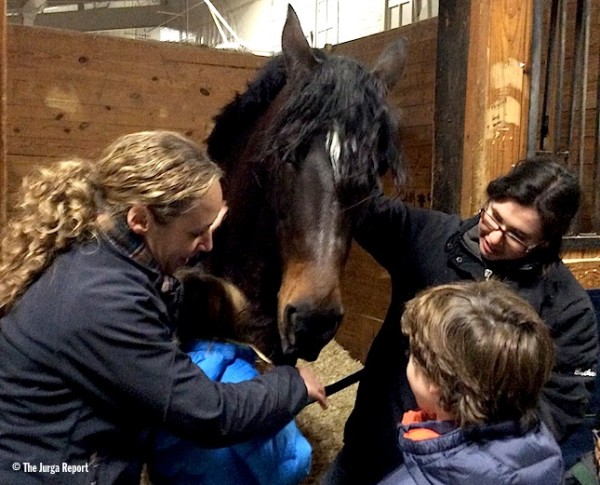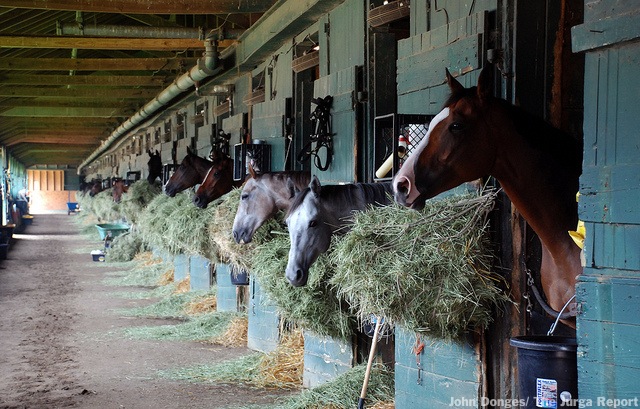What worries you? Owners search for horse health answers at Equine Affaire
- March 10, 2017
- ⎯ Fran Jurga

They came, they parked (eventually), they shopped. And they asked questions.
For the 15th consecutive year, Equine Affaire hosted a successful breed and sport exposition in West Springfield, Massachusetts. Held last weekend at the Eastern States Exposition showgrounds, the event has become a favorite outing for horse owners and exhibitors alike.
It’s a great opportunity for me to take the pulse of the crowd and see what’s selling and what’s on people’s minds. With 475 exhibitors spread out over five exhibit halls, there’s something for every aspect of horsemanship and horse care.
Exhibitor after exhibitor told me that they like this event because the horse owners are well-educated on horse products. There’s no need to “sell” them on supplements or training aids or seminars, they are already on board. It’s merely a matter of tuning in to their current concerns.
Currently, it seems, the concerns of New England horseowners are focused on the stomach, and the digestive tract in general. The diagnosis of ulcers or the fear of them seemed to have hit almost everyone. They were determined to either prevent them, or a relapse.
And where did they look for answers? You could find some with their noses stuck in reference books at the Taborton or Knight Equestrian bookshops. Some lined up to ask veterinarians and staff at the Tufts University Cummings School of Veterinary Medicine, South Shore Equine, Myhre Equine or New England Equine Medical Center booths.
A stalwart sense of brand loyalty binds horse owners to sales consultants at supplement companies like Grand Meadows, Life Data Labs, SmartPak Equine and Uckele—among many others. Others tentatively checked out new ideas, such as Wellpride’s Omega-3 fish oil or any number or prebiotic or probiotic formulas.
Merial had a booth to explain the Gastrogard and UlcerGard ulcer treatment products that most owners are using, but the big concern seemed to be beyond the medication. Once the course of meds is complete, what can be done?
They were on a mission to compare supplements designed for gastrointestinal health, to compare claims or pre- and probiotics, and to see what else is out there.
In particular, there was a huge interest in slowing down feeding, in order to normalize digestion. And this was where several horse owners admitted to feeling guilty. Guilty enough to pay $500 for a plastic bucket for their horse to eat hay from while they were at work.
The guilt comes from the fact that they have to go to work in the morning and they can’t get home until night, so the horses may spend time without hay. Does this actually cause ulcers? Since racehorses are known to have ulcers and usually have a hay net in their stalls, are these horseowners experiencing misplaced guilt?

When did hay get so complicated?
Things we used to worry about hay: did we have enough? could we afford it? was it good enough? were the horses wasting it? were the older horses chewing it properly? what was living up in the hay loft?
Hay nets were something you kept in the trailer, or used at shows. You worried how big the squares were in relation to your horse’s hooves. No one was a connoisseur of hay nets, until recently. And there were no designer hay nets. But now…
At some point, it became necessary to think about having different hay for different horses in the barn, especially if there were competition horses living side by side with sedentary horses or older horses. You always wondered if your hay was good enough.
Then Equine Metabolic Syndrome and “easy keeperism” had us thinking long and hard about the quality and quantity of hay fed to each horse. Hay soaking and testing of hay for sugar or starch content was recommended. How much wiggle room is there?
When it came to feeding hay to horses turned out, there was more concern about bullying behavior and making sure that everyone had a share. Hay feeders seemed like a good idea to provide enough hay to keep horses eating through the day but that translated to overweight horses who stood by feeders all day.
There are many ways to slow a horse down. You can double net hay. You can buy small-mesh hay bags. You can buy any number of ingenious bulk hayfeeders. And the crowd at Equine Affaire did. That $500 plastic hay bucket has a track down the inside for the feeding grid to follow. It’s very clever, and patented, too.
But do you really want a horse to stand still all day with his head in a hay feeder while you’re at work? Slow feeding is a great concept, but the ideal way to do it is probably to have a big pasture with several feeders and to make sure the horses move around during the day, or at least from feeder to feeder.
For an eye-opening experience, go to youtube.com and type “horse slow feeder” into the search bar. There are simple and complicated solutions, homemade and manufactured alternative. And no two are alike. People have been very creative at solving this problem, whether it’s to save money on hay, try to reduce their horses’ weight, or keep them eating over a longer period of time because they’ve been told that is good for ulcers.
I’d love to know if studies have been done of horses that don’t have ulcers. If we could find out what their lifestyle and diet is like, that might be some valuable information to pass around.
Forward thinking
In the meantime, people are trying to help with new ideas. The “paddock paradise” concept, originally conceived by horseman Jaime Jackson, keeps horses moving all day by spacing their hay out on a track. I think this idea also keeps their minds engaged a bit, as well, but it is limited by your ability to rearrange the landscape where your horses live, and requires more acreage than the small paddocks of some suburban horses. But there’s always weekends…
In Australia, research is exploring an automatic feeding system that actually closes its door after a given amount of time. In order to get more hay, the horse has to go for a long walk around to the other side of the feeder–which is separated by fence–to access the open door. The unit switches doors throughout the day, forcing the horse to make periodic treks to get more hay.
I’ll ask again, when did hay get so complicated? The obvious answer: Probably about the same time that horses became so complicated.
One thing that may be getting less complicated is the treatment of ulcers themselves. While Merial owns the turf with its Gastrogard and UlcerGard omeprazole products, a study published this fall in the Equine Veterinary Journal found that a lower dose was just as effective in racehorses with ulcers.
The concluding statement of the study reads “The results of this study suggest that…where omeprazole is administered before exercise and following a brief fast, doses of omeprazole as low as 1 mg/kg bwt per os s.i.d. may be as effective as higher doses. The proportion of glandular ulceration that heals with 28 days of omeprazole therapy is less than that of squamous ulceration.”
What worried people at Equine Affaire was facing a new challenge. We’ve faced so many before. Creativity, cooperation and entrepreneurship have won the day for our horses before and will surely do it again.
To learn more:
Hampson, B. A., de Laat, M. A., Monot, J., Bailliu, D. and Pollitt, C. C. (2013), Adaption of horses to a novel dynamic feeding system: Movement and behavioural responses. Equine Veterinary Journal, 45: 481–484. doi: 10.1111/evj.12002
Sykes, B. W., Sykes, K. M. and Hallowell, G. D. (2014), A comparison of three doses of omeprazole in the treatment of equine gastric ulcer syndrome: A blinded, randomised, dose–response clinical trial. Equine Veterinary Journal. doi: 10.1111/evj.12287





